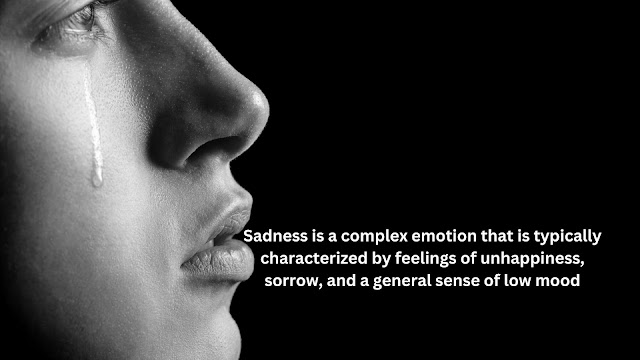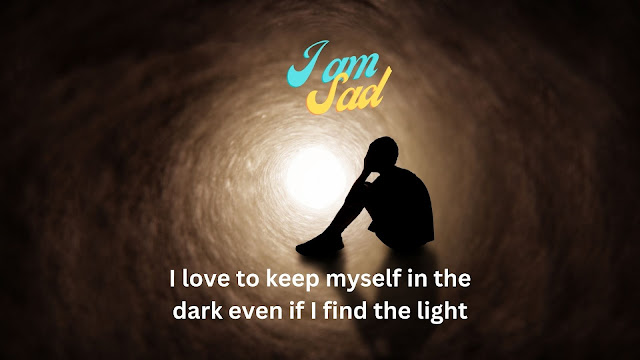TABLE OF CONTENT
- How Do You Explain Sadness
- What does Sadness do to a person
- What Emotion is Behind Sadness
- Types of sadness in psychology
- How to deal with Sadness Alone
Sadness Psychology | How to Deal with Sadness Alone?
Understanding Sadness
How Do You Explain Sadness:
Sadness is a complex emotion that is typically characterized by feelings of unhappiness, sorrow, depression and a general sense of low mood. It can be triggered by a variety of factors, such as a personal loss, a difficult life event, or a sense of isolation or disconnection from others.
From a physiological perspective, sadness can manifest in a number of ways. For example, people who are feeling sad may experience physical symptoms such as a heaviness in the chest, fatigue, a lack of energy or motivation, and changes in appetite or sleep patterns.
At a psychological level, sadness often involves a sense of loss or grief, which can lead to feelings of hopelessness, despair, or anxiety about the future. People who are feeling sad may also withdraw from social interactions, experience a loss of interest in activities they used to enjoy, and struggle with negative thoughts or self-criticism.
Overall, sadness is a normal and natural part of the human experience, and can be an important signal that we need to pay attention to our emotional needs and seek support from others.
Effects of sadness:
What does Sadness do to a person:
Sadness is a complex emotion that can affect a person in various ways, both emotionally and physically. Here are some of the common effects of sadness on a person:
- Emotional Effects: Sadness can cause a range of negative emotions, such as feeling overwhelmed, hopeless, and helpless. It can also lead to feelings of loneliness, isolation, and low self-esteem. A person who is sad may withdraw from social activities, lose interest in hobbies or other enjoyable activities, and have difficulty concentrating or making decisions.
- Physical Effects: Sadness can also have physical effects on the body. It can cause symptoms such as fatigue, loss of appetite, difficulty sleeping, and headaches. In some cases, it can also lead to physical ailments such as weakened immune system and chronic pain.
- Cognitive Effects: Sadness can affect a person's thought processes and cognitive abilities. It can cause negative thought patterns, such as rumination and self-blame, and can impair a person's ability to think clearly and make rational decisions.
- Behavioral Effects: Sadness can also affect a person's behavior. It can lead to avoidance of certain situations, increased alcohol or drug use, and other risky behaviors. In some cases, it can also lead to suicidal thoughts or actions.
What Emotion is Behind Sadness:
Sadness is often described as a primary emotion, which means it can be experienced on its own, without necessarily being triggered by another emotion. However, it can also be associated with other emotions that contribute to its intensity or duration.
Some emotions that may be associated with sadness include:
- Grief: Sadness is often associated with grief, which is the emotion experienced in response to loss or the anticipation of loss.
- Disappointment: Sadness can also be associated with disappointment, which is the emotion experienced when our expectations are not met.
- Loneliness: Sadness can also be associated with loneliness, which is the emotion experienced when a person feels isolated or disconnected from others.
- Guilt: Sadness can be associated with guilt, which is the emotion experienced when a person feels responsible for a negative outcome or event.
- Helplessness: Sadness can also be associated with helplessness, which is the emotion experienced when a person feels unable to control or influence a situation.
It's important to note that the underlying emotion behind sadness may vary from person to person and situation to situation.
Types of sadness in psychology:
In psychology, there are different types of sadness that are recognized and studied. Here are some of the common types:
- Clinical Depression: Clinical depression is a type of sadness that is characterized by persistent feelings of sadness, hopelessness, and worthlessness. It can also be accompanied by other symptoms such as changes in appetite and sleep patterns, loss of interest in activities, and difficulty concentrating.
- Bereavement: Bereavement is a type of sadness that is experienced in response to the loss of a loved one. It can be characterized by feelings of grief, emptiness, and loneliness.
- Seasonal Affective Disorder (SAD): SAD is a type of sadness that is linked to changes in the seasons. It typically occurs during the winter months when there is less sunlight, and can be characterized by feelings of sadness, low energy, and changes in appetite and sleep patterns.
- Situational Sadness: Situational sadness is a type of sadness that is triggered by a specific event or situation, such as a breakup or a job loss. It can be characterized by feelings of disappointment, sadness, and grief.
- Existential Sadness: Existential sadness is a type of sadness that is related to the larger questions of life, such as the meaning of existence, mortality, and human suffering. It can be characterized by feelings of despair, hopelessness, and a sense of futility.
It's important to note that sadness can manifest differently in different people, and that the types of sadness listed here are not exhaustive. Additionally, sadness can be a normal and healthy response to certain situations, and it is only when it becomes persistent or interferes with daily functioning that it may be considered a problem.
How to deal with Sadness Alone:
Dealing with sadness alone can be challenging, but there are several strategies that may help:
- Acknowledge and accept your emotions: It's important to recognize and accept your emotions, including your sadness. Give yourself permission to feel your emotions and don't judge yourself for having them.
- Practice self-care: Take care of yourself by eating well, getting enough sleep, and engaging in physical activity. Engage in activities that you enjoy, such as reading a book or listening to music.
- Connect with others: Even if you're feeling sad, it's important to maintain social connections. Reach out to friends or family members who can provide support and companionship. Alternatively, consider joining a support group or seeking professional help from a therapist.
- Practice mindfulness: Mindfulness involves focusing on the present moment and accepting your thoughts and feelings without judgment. Practicing mindfulness techniques, such as meditation or deep breathing exercises, can help you manage your emotions.
- Seek distractions: Engage in activities that can help distract you from your sadness, such as watching a funny movie, playing a game, or working on a project. However, it's important to balance these activities with self-care and other healthy coping strategies.
- Write it out: Writing about your feelings can be a helpful way to process your emotions. Consider keeping a journal or writing letters to yourself or loved ones.
It's important to note that everyone experiences sadness differently, and the effects of sadness can vary depending on the individual and the situation. If sadness is interfering with a person's daily life, it's important to seek professional help from a therapist or other Mental Wellness Coach.
FAQ
















0 comments:
Post a Comment
Thank you for your response